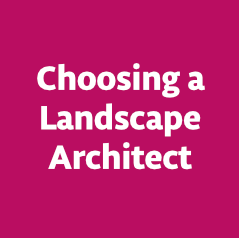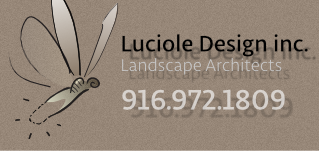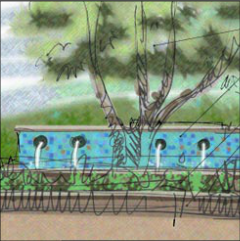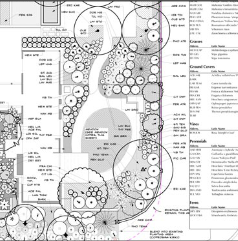
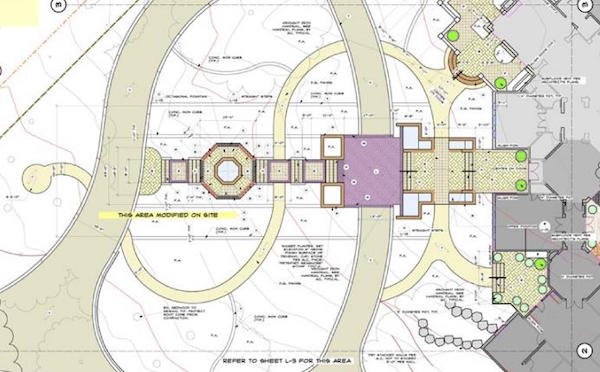
How to choose a landscape architect...
These are some things you might ask a potential designer before you work with them. Another useful method of choosing a designer is to pay for a design consultation from several designers to get a series of options and see how each one approaches the design of your space.
Ask to see some sample plans
Normally, designers communicate their initial concepts with sketches and plans. These drawings should be clear, and there should be enough notes so that you can get a fairly clear idea of the concepts being presented. Once a concept has been chosen, the project moves into construction plans that are more complicated - they're what you'll give to contractors for bids and to construct your project.
Do the initial drawings have perspective sketches? Are they in color?
Are there enough notes so you can read what's being proposed?
How much detail is in the construction plans? Do they specify materials, plants, lighting, drainage fixtures? Do they contain notes about standards, best practices, and other information that can result in a smoother installation and more successful project?
What skills do they use?
How well are the plans drafted? A plan should have a varity of line weights (thicknesses) that make it easier to read. Shaded or hatched areas help delineate different surfaces. Notes and dimensions should be dense yet clearly readable.
Can they draw? If you're getting perspectives and other illustrations, how do they look? Thin and scratchy or bold and clearly delineated?
Do they use computer-aided design (CAD)? Some of the most beautiful drawings are still done by hand. It's an art form - but CAD has the advantage of being easy to share (as pdf files), and it does accelerate the process by automating tasks like counting plants and fixtures.
Can they do 3D modeling? This typically raises the cost of your plans, but it also lets your desinger generate many perspective views of the proposed project, giving you a much better idea of how the new landscape will appear when built. It also can be used during presentation meetings for virtual walk-throughs of the project.
Who is doing my design?
How much involvement will the principal have with your design? If a designer is mainly involved with publishing, television and magazines, they might be too busy pursuing these activities to actually work with you on your project. Do you want to pay that much money to have a student intern or draftsperson work out your design?
What is your typical scope of services?
The scope of services can vary by project. For example, we offer different design packages at different price points whose scope of services vary. Make sure you check what's included in the plan you're considering.
How many meetings are included? What drawings and plans will be done? How about design revisions?
Do their fees include site measurement or surveys - if they don't, you may need to pay a surveyor unless you already have a survey done after your home or building was constructed. Large and hilly sites almost always require a survey, unless you're only developing a small area.
What to look for on construction drawings
Are the drawings clearly organized? Do they show dimensions? If a structure or special feature is called for, is there a scaled detail (or manufacturer's reference) for it? What does it include?
Does it show layout, planting, construction details, notes, lighting, drainage, irrigation? If something isn't there, why not? (we don't normally include irrigation because the contractors we work with can do it without plans - so you don't pay for them twice).
What details do they provide with their basic plans? Are the details custom drawn for your project or "boilerplate" that apply to just about everything?
Can I see a typical contract? What is your typical price range?
When do you need to make payments, and how are they distributed? How much money would you have to pay up front? When are payments due? Can you tell how much their services will cost and what is included in their base fee? How many revisions can you make before they charge extra service fees?
Looking at portfolios
The current trend is to post images of built projects online so you can look at their work any time, and the architect or designer can update it as new projects are photographed. However the work is presented, it should clearly represent the designs and be large enough to see easily (unless you're looking at it on your phone!). Some portfolios include sketches as examples of concept communication and to show ideas that are interesting but were not built for whatever reason.
You can ask the designer about certain projects in their porftolio: what was the design process used to arrive at that solution, what was the rough budget, what hidden features are in the design that don't show in the photograph - like underground infrastructure, pervious drainage systems, ecological factors...
Do the landscapes they've built match your style? Do they match your budget? The designer should have an idea how much their built projects cost.
Interviews & Consults
Talk to the designer, ask about things you'd like to include in your new landscape, issues such as sustainable design, or a style you'd like to create.
Do you have a good personality match with the designer? Do their ideas make sense and fit your budget? Do they listen to what you're saying? This is where you can use consults to good effect - it's a lot better to pay several hundred dollars for on-site consults than to be stuck with a designer you have trouble working with.
What is the architect's background? Have they travelled, explored other designs? It's possible that they haven't been to the specific place you visited in another country, but they may have seen something similar and have a good idea of the style you're looking for.
What level of education do they have? Are they designers or landscape architects? What range of projects have they worked on?
Ask for references? Maybe not.
If you ask for references, you'll get a list of people they know will give glowing reviews. You can always ask, but any dissatisfied people wont' be on the list.
We prefer giving non-client references like architects and contractors who know our work and who have worked with us over numerous projects. (We do have client references if you want them.)
copyright 2016 Luciole Design inc.
